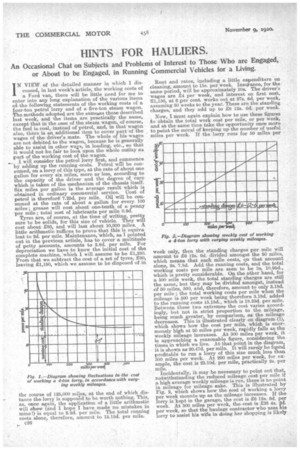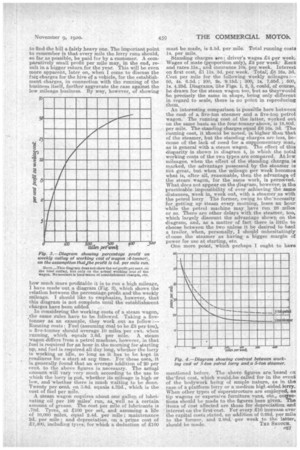HINTS FOR HAULIERS.
Page 20

Page 21

If you've noticed an error in this article please click here to report it so we can fix it.
An Occasional Chat on Subjects and Problem's of Interest to Those WhO are Engaged, or About to be Engaged, in Running Commercial Vehicles for a Living.
IN VIM of the detailed manner in which I discussed, in last week's article, the working costa of a Ford van' there will be little need for me to enter into any long explanation of the various items of the following statements of the working costs of a four-ton petrol lorry and of a five-ton steam wagon. The methods adopted are the samelas those, described last week, and the items are practically the same, except that in the case of the steam wagon, of course, the fuel is coal, instead of petrol, and, in that wagon also, there is an additional item to cover part of the wages of the driver's mate. The whole of his wages are not debited to the wagon, because he is generally able to assist in other ways, in loading, etc., so that it would not be fair to look upon. the whole outlay as part of the working cost of the wagon.
,._ I will consider the petrol lorry first, and commence by adding up the running costs. Petrol will be consumed, on a lorry of this type, at the rate of about one gallon for every six miles, more or less, according to the capacity of the driver and the degree of care which is taken of the mechanism of the chassis itself. Six miles per gallon is the average result which is obtained in ordinary commercial service. Cost of petrol is therefore 7.25d. per mile. Oil will be consumed at the rate of about a gallon for every. 100 miles; grease will cost about one-tenth of a penny per mile ; total cost of lubricants per mile 0.9<1.
Tyres are, of course, at the time of writing, pretty sure to be solid's, for this size of vehicle. They will cost about 280, and will last about 10,000 miles. A little arithmetic tuffices to prove that this is equiva lent to 2d. per mile. Maintenance, 'which, as I pointed out in the previous article, has to cover a multitude of petty accounts, amounts to 2.8d. per mile. For depreciation we have to know the initial cost of the complete machine 'which I will assume to be 21,230. From that we subtract the cost of a set of tyres, 280, leaving 21,150, which we assume to be disposed of in the course of 125,000 miles, at the end of which distance the lorry is supposed to be worth nothing. This, as, cvnce again, the application of a little arithmetic will show (6nd. I hope I have made no mistakes in mine!) is equal to 2.2d. per mile. The total running costs alone, therefore, amount to 15.15d. per mile.
C26 Rent and rates, including a little expenditure on cleaning, amount to 15s. per week. Ins4ance, for the same period, will be approximately 10s. The driver's wages are 24 per week, and interest on first cost, 21,1501 at 6 per cent, works out at 27s. 6d. per week, assuming 50 weeks to the year. These are the standing charges, and they add up to 26 12s. 6d. per week.
Now, I must again explain how to use these figures to obtain the total work cost per mile, or per week, and at the same time take the opportunity once more to point the moral of keeping up the number of useful miles per week. If the lorry runs for 50 miles per
week only, then the standing charges per mile will. amount to 26 12s. 6d. divided amongst the 50 miles, which means that each mile costs, on that account alone 2s. '7.8d. Add the running cost's and the total working costs per mile are seen to costs, 3s. 10.95d., which is pretty considerable. On the other hand, for a 500 mile week, the total standing charges are still the same, but they may be divided amongst, instead of 50 miles 500, and, therefore, amount to only 3.18d. per mile ; ?the total working costs per mile when the mileage is 500 per week being therefore 3.18d. added to the running costs 15.15d., which is 18.33d. per mile. Between these two extremes the cost varies accordingly, but not in strict proportion -to the mileage, being much greater, by comparison, as the mileage decreases. This is illustrated clearly on diagram (1), which shows how the cost per mile, which is enormously high at 50 miles per week, rapidly fails as the weekly mileage increases. At 300 miles per week, it is approaching a reasonable figure, considering the times in which we live. At that point in the diagram, it is shown as 20.47d. per mile. It will rarely be fund profitable to run a lorry of this size much legs than BOO miles per week. At 200 miles per week, for example, the cost is 23.10d. per mile, practically 2s. per mile.
Incidentally, it may be necessary to point out that, notwithstanding the reduced mileage cost per mile if a high average weekly mileage is run, there is no point in mileage for mileage sake. This is illustrated by Fig. 2, which shows how the cost of working a lorry per week mounts up as the mileage increases. If the Jerry is kept in the garage, the cost is 26 12s. 6d. per week. At 500 miles per week, the cost is 238 4s. 2d. per week, so that the haulage contractor who uses his lorry to 4:mist his wife in doing her shopping is likely to find the bill a fairly heavy one. The important point to remember is that every mile the lorry runs should, so far as possible, be paid for by a. customer. A comparatively small profit per mile may, in the end, result in. a bigger return for the year. This will be even more apparent, later on, when I come to discuss the faii charges for the hire of a vehicle, for the establishment charges, in connection with the running of the business itself, further aggravate the case against the low mileage business. By way, however, of showing hew much more profitable it is to run a high mileage, I have made out a diagram (Fig. 3), which shows the relation between the percentage profit and-the weekly mileage. I should like to emphasize, however, that this diagram is not complete until the establishment charges have been added.
In considering the working costs of a steam wagon, the same rules have to be followed. Taking a fivetanner as an example, they work out as follow :— Running costs : Fuel (assuming coal to be 23 per ton), five-tonner should average 10 miles per cwt. when running, which equals 3.6d. per mile. A steam wagon differs from a petrol machine, however, in that fuel is required for an hour in the morning for starting up, and fuel is required all day long, whether the lorry is working or idle, so long as it has to be kept in readiness for a start at any time. For these uses, it is generally found that an average 'addition of 20 per cent. to the above figures is necessary. The actual amount will vary very much according-to the use to which the lorry is put, whether its mileage is high. or low, and whether there is much waiting to be done. Twenty per cent. on 3.6d. equals 4.32d., which is the Cost of fuel per mile. A steam wagon requires about one gallofl, of lubri cating oil per 100 miles' run, as_well as certain amount of grease. The cost per mile of lubricants is .78d. Tyres, at £100 per set, and assuming a life of 10,000 miles, equal 2.41. per mile ; maintenance. 2d. per mile ; and depreciation, on a prime cost of 11,400, including tyres, for which a deduction of 1100
must be made, is 2.5d. per mile. Total running costs Is. per mile.
Standing charges are: driver's wages £4 per week. Wages of mate (proportion only), R2 per week: Rent and rates 15s.,_ aria insurance 109. per meek. Interest on first cost, .X1 11s. 3d. per week. Total; LB 16s. 3d. ,Cost per mile for the following weekly mileages:50, 4s. 6.3d. ; 100, 2s. -9.15d. ; 300, is. 7.05d. ; 500, Is. 4.23d. Diagrams, like Figs. 1, 2, 3, could, of course, be drawn for the steam wagon too, but as therwonld be precisely the same in shape, being only different in regard to scale, there is no point in reproducing them.
An interesting comparison is possible here between the cost of a five-ton steamer and a five-ton petrol wagon. ' The running cost of the latter, worked out on the same basis as the four-tonner above, is 18.80d. per mile. The standing charges equal £6 16s. 3d. 'The running cost, it.should be noted, is higher than that of the steamer, but the standing charges are-less, because of the lack of need for a. supplementary man, as is general with a steam wagon. The effect of this disparity is shown in diagram 4, in which the total working costs of the two types are compared. At low mileages, when the effect of the standing charges marked, the advantage possessed by the steamer is not great, but when the mileage per week becomes what is, after all, reasonable, then the advantap of the steam wagon, for thesame work, is perceived. What does not appear on the ,diagrarn, however; is the practicable impossibility -Of ever achieving the same distances, week in, week out, with a steamer as with the petrol lorry. The former, owing to the 'necessity for getting upSteam every morning, loses an hour -while the petrol machine may have run 20 miles or so. There are other delays with the steamer, too, which largely discount the advantage shown on the diagram-, and, as a matter of fact there is little to choose between the two unless it be desired to haul a trailer, when, personally, I should unhesitatingly doomthe. steamer as having: a bigger margin of power for use at starting, etc. One more point, which perhaps I ought to have mentioned before. The • above figures are., based ori the'first cost, which would.;.he called for in the event of the bodywork being of simple nature, as in the case of a platform lorry or a medium high-sided-lorry. When other types of superstructure are employed, as tip wagons or expensive furniture vans, etc., corpetions should be made to the figures here given. The items of cost affected are those for depreciation and interest -en the first cost. For every 110 increase over the capital costs stated, an addition of 0.02d. per mile to the former, and 2.88d. per week to the latter„ should be made. Tun SHOTCH.
• n27




























